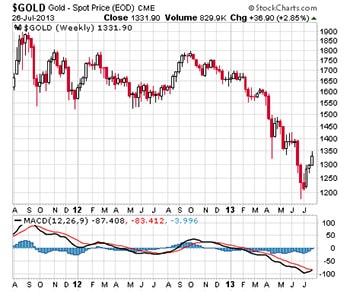Investors anxiously await another all-important announcement from the Federal Reserve this week. In the meantime, today's Market Update will shine a technical spotlight on the current price action in precious metals. Some extremely interesting developments are taking place, particularly in gold.
Gold has an opportunity to build on some positive weekly momentum. Prices closed up for the third week in a row last Friday, marking the metal's biggest sustained rally of the year. The rally is starting to turn around the weekly MACD (moving average convergence divergence) oscillator (see chart).

The MACD had been on a bearish crossover since late last fall. It fell to a reading of -100 at the end of June, a mirror image of the +100 reading seen at the August 2011 high. Now the black MACD trigger line is turning up and is on the verge of producing a bullish crossover, which often signals an intermediate-term trend change.
Gold prices encountered some resistance last week at the $1,350/oz level. A solid close above that level should usher in more buying and induce more short covering by traders in the futures markets. Hedge funds have unwound some of their record short positions from the spring, but a great deal more potential unwinding remains.
Meanwhile, the key level for silver remains $20/oz. Silver has flirted with but failed to hold above $20 for five weeks straight. If a precious metals rally with legs is to get going, we need to see silver – the more volatile of the two metals – start to outperform gold. First, we need to see a strong weekly close above $20.
Western Gold Gets Tight as Asia Soaks Up Supply
Although we encourage long-term investors to remain focused on the physical fundamentals that ultimately drive the major trends for precious metals prices, in the short term, the paper markets rule.
London-based analyst Paul Mylchreest notes that the paper and derivatives market for gold is 92 times bigger than the actual physical market. According to Mylchreest, "...the gold market is a gigantic fractional reserve system consisting of a vast quantity of paper claims to gold bullion and a much smaller inventory of actual bullion."
In other words, there aren't anywhere near enough inventories of physical gold to satisfy the demand represented by the multitudes of derivative products attached to gold prices. Even a small shift away from synthetic gold to the real thing would have explosive consequences for the physical market.
And that shift is now occurring...
In the past three weeks, we have seen the spot market price of gold rise above the near-term futures market price. This is called backwardation, an extremely unusual condition in precious metals. Backwardation signals extreme tightness in the supply of physical gold for immediate delivery.
As prices on the paper markets in London and New York have fallen to seemingly ridiculous lows, more owners of contracts and gold ETF shares have stood for physical delivery of their gold than usual, and in many cases, they are arbitraging the higher physical market prices offered in Asia.
So hundreds of tonnes of physical gold are moving from the West to the East, as institutional investors have discovered a profit can be made by facilitating the transfer of the yellow metal into new vaults in places like Mumbai, Singapore, Shanghai, and Hong Kong.
Potential Market-Moving News This Week
This week will be eventful on the economic news front. Investors should brace for potential market volatility.
- Tuesday, July 30th – Case-Shiller Home Price index; Consumer Confidence index.
- Wednesday, July 31st – GDP report; FOMC announcement. The Federal Open Market Committee is slated to release a statement following its two-day meeting. Lately, the Fed has sounded a dovish tone. Language confirming that "tapering" of the Fed's extraordinary $85 billion in monthly bond purchases will not occur could boost the equity and precious metals markets. Any hints to the contrary could cause investors to sell assets.
- Friday, August 2nd – Employment report. The consensus is for the U.S. official unemployment rate to come in at 7.5%. Federal Reserve Chairman Ben Bernanke has reiterated the Fed's intent to pursue accommodative monetary policy as long as the official unemployment rate (which Bernanke himself recently said "probably understates the weakness of the labor market") exceeds 6.5%.

About the Author:
Clint Siegner is a Director at Money Metals Exchange, a precious metals dealer recently named "Best in the USA" by an independent global ratings group. A graduate of Linfield College in Oregon, Siegner puts his experience in business management along with his passion for personal liberty, limited government, and honest money into the development of Money Metals' brand and reach. This includes writing extensively on the bullion markets and their intersection with policy and world affairs.






